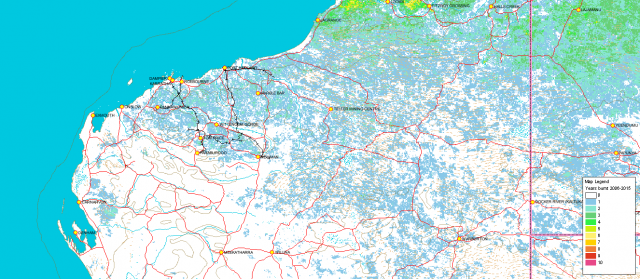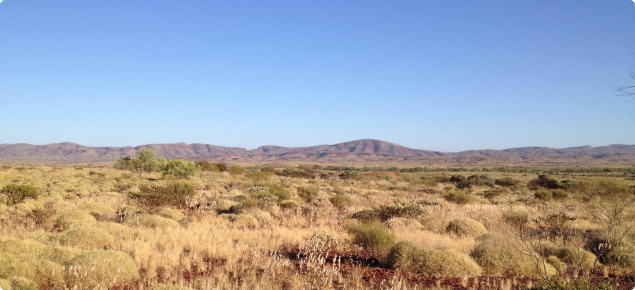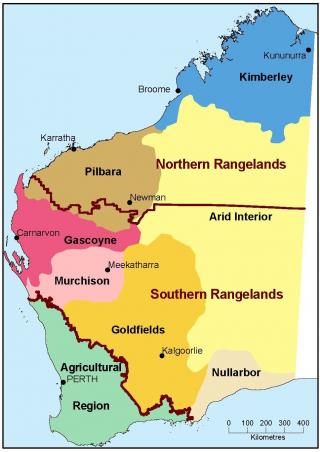The complex effects of fire
Fire, grazing and weather interact in complex ways to affect rangeland condition and livestock production.
Recently-burnt pastures that are regenerating have relatively high productivity, diversity and palatability that is an important resource for many native flora and fauna species. Long-unburnt areas are important for providing breeding and shelter requirements of native fauna and for species with long life cycles, such as mature tree parasites, saprophytes and fungi. Managing fire in the rangelands needs to balance these two factors.
We recommend monitoring rangeland condition, including response to fire, and adapting fire management to the needs of the ecosystem, pasture type and use, management, safety and season. Fires affect land systems and pasture types in different ways and have cumulative effects over time.
These guidelines for the Pilbara (Figure 1) are based on experience and research, providing a starting point for fire management at the property scale.
The Pilbara is a fire-prone environment
Pilbara rangeland managers operate in a fire-prone environment (Figure 2). Most of the area is burnt at least once a year.
Uncontrolled fires pose significant economic, safety, and environmental risks to pastoral enterprises. In contrast, using controlled fire can benefit land management, animal production and biodiversity conservation.

Reducing the risk of damage from fire
You can reduce the risk of damage from fire by:
- applying the general principles linked below
- using the visual fuel load guides available from Department of Fire and Emergency Services (DFES)
- using the guidelines for managing pastures with fire in different types of country.
Research from the Pilbara shows that post-disturbance pasture recovery (including recovery from fire) is strongly correlated with favourable seasonal conditions and good total grazing pressure control.
General principles for managing fire
Uses and timing of planned fires
Most managers in the northern Pilbara plan to burn just before or just after opening rains late in the winter (or 'dry') season to reduce fuel loads and rejuvenate rank pastures. Some managers use high-intensity fire to kill shrubs. Planned fires in the Pilbara have tended to move from early or middle dry season to later in the dry season: these later burns are generally hotter, which is a risk, but have pasture production advantages.
Moderate- to high-intensity fires are used to manage the balance between trees and shrubs versus grasses and remove unpalatable and low-digestibility mature plant material, allowing new growth of more desirable species.
In general, early dry-season burns:
- are 'cooler' and less likely to kill trees and shrubs
- reduce overall pasture production in the year of the burn
- reduce production by perennials (grasses, shrubs and trees, especially if grazing resumes soon after fire)
- increase the proportion of production by annuals
- produce less greenhouse gas emissions than from late dry-season burns
- reduce the risk of wildfires later in the season.
In general, late dry-season burns:
- are hotter and more likely to kill trees and shrubs
- have little effect on total annual yield
- have higher greenhouse gas emissions than from early dry-season burns
- have an increased risk of damage from hot fires.
Maintaining the shrub–grass balance
Burning can reduce tree and shrub density (woody thickening) in the productive grasslands of the tropical savannas. Without burning, tree and shrub density may increase over many years to the point where grass production is reduced through competition for nutrients and water resources, and mustering is more difficult (and more expensive).
Deliberate use of moderate- to high-intensity fires to manage the balance between trees and shrubs versus grasses requires careful preparation and skilled management to prevent fires ‘getting away’. The taller the tree or shrub, the more intense the fire needs to be to kill the woody plants. For some trees, there is a critical height above which the population will be unaffected by fire intensity in the understorey of the natural vegetation.
DFES provides recommendations on conditions for producing fire intensities suitable for controlling woody plants of various heights.
How flaming often?
This depends mostly on the pasture type, land system and climatic conditions preceding the burn. Details are given below for different types of country.
Guidelines for managing pastures with fire on different types of country
Tussock grassland and extensive river floodplain pastures
Do not routinely or regularly burn these pastures because there is an unacceptably high risk of post-fire erosion and reduced available feed.
Precautionary firebreak preparation and local fuel reduction may be appropriate where there have been exceptional seasons for grass growth and the threat of damaging wildfire exists.
Burn prior to winter when there is still some soil moisture for perennial grass regrowth on this type of country.
To control woody weeds, use targeted, consecutive, carefully timed burns and post-fire livestock control to allow groundcover plants to regenerate. Fire can be used on productive river floodplains to control undesirable flood-responsive shrubs, such as Cullen spp. (verbines) and Acacia farnesiana (prickle bush), if trampling and grazing are limited.
Spinifex pastures
Spinifex pastures in the rangelands provide enough fuel to carry fires on a regular basis. Spinifex pastures in the Pilbara tend towards spinifex dominance with grazing. Annuals and desirable perennial grasses that are present in post-fire spelled pastures increase productivity of these pastures for livestock in the short to medium term.
See Spinifex rangeland pastures and fire for more information.
Mallee shrubland, sandplain and mixed acacia woodland pastures
See Arid zone rangeland pastures and fire
Chenopod shrublands, samphire and forb-land pastures
See Arid zone rangeland pastures and fire
References
- Cowley, R, Pettit, C, Cowley, T, Pahl, L & Hearnden, M 2012, 'Optimising fire management in grazed tropical savannas’ in Proceedings of the 17th Australian Rangeland Society Biennial Conference, Australian Rangeland Society, Australia.
- Florentine, SK 1999, Ecology of Eucalyptus victrix in grassland in the floodplain of the Fortescue River, doctoral thesis, Curtin University of Technology, Perth.
- Ryan, K, Novelly, P & Dray, R 2013, Grazing land management – Pilbara version, workshop notes, EDGEnetwork Future Beef Program, Meat and Livestock Australia.
- Stretch, J 1996, ‘Fire management of spinifex pastures in the coastal and west Pilbara’, Miscellaneous publication 23/96, Department of Agriculture, Western Australia, Perth.
- Stretch, J & Addison, J (eds.) 2005, Fire management guidelines for southern shrubland and Pilbara pastoral rangelands, Best management practice guidelines series, Department of Agriculture and Food, Western Australia, Perth.
- Suijdendorp, H 1967, A study of the influence of management practices on “spinifex” Triodia pungens grazing, masters thesis, University of Western Australia, Perth.
- Walsh, D, Crowder, S, Saggers, B & Shearer, S 2012, 'Early wet season burning and pasture spelling to improve land condition in the Victoria River District, NT', in Proceedings of the 17th Australian Rangeland Society Biennial Conference, Australian Rangeland Society, Australia.



